The Education Department will forgive $5.8 billion in student loans taken out by borrowers who became seriously disabled, the latest in a series of reforms to a troubled program that left many vulnerable borrowers mired in debt they couldn’t repay.
A 2011 investigation by ProPublica, published in partnership with Columbia University’s Stabile Center for Investigative Journalism, revealed that a flawed Education Department program for assessing disability was leaving many borrowers facing financial hardship from federal student loans they were legally entitled to have dismissed.
Under the new regulation, the department will automatically forgive the debt of borrowers who the Social Security Administration has identified as severely disabled. The department will also move to eliminate a three-year monitoring period after loan discharges that led many borrowers with disabilities to have their debts reinstated due to difficulties with paperwork.
“We’ve heard loud and clear from borrowers with disabilities and advocates about the need for this change,” said U.S. Secretary of Education Miguel Cardona when the department announced the reforms in August. “This change reduces red tape with the aim of making processes as simple as possible for borrowers who need support.”
Our investigation a decade ago found that bureaucratic obstacles often prevented borrowers from getting their loans forgiven. In one case, a borrower in a vegetative state was placed in default for failing to provide the department with income verification. The department had ignored internal recommendations to scrap its dysfunctional review process altogether and accept disability findings from the Social Security Administration.
Weeks after the story was published, the department announced the first in a series of reforms, pledging to write new rules to revamp the program. In 2012, the department agreed to recognize some Social Security disability findings. And in 2016, it sent out letters inviting an estimated 387,000 borrowers with the Social Security designations to file a simplified application form for debt relief.
The department’s latest move goes significantly further: It automatically discharges the debts of borrowers who the SSA has determined to be fully disabled. The department will identify these borrowers through a data match rather than requiring them to file applications.
“Providing this relief automatically is a huge deal,” said Persis Yu, the director of the National Consumer Law Center’s Student Loan Borrower Assistance Project. “Notifying folks is not enough.”
Yu said that problems such as outdated mailing addresses, as well as the difficulties many individuals with disabilities face in completing the application process, meant that the majority of eligible borrowers didn’t get the relief they were entitled to receive.
Of the more than 800,000 borrowers identified in Social Security data matches as being entitled to relief, only about 300,000 had gotten it, according to a recent report by Yahoo! Finance. The department said the overall number contained some duplicates, and estimated that an additional 323,000 borrowers will have their debts forgiven under the new policy.
The other key element of the new reform is that the government will no longer force borrowers to prove they aren’t earning income in order to keep loan forgiveness. In October, it will begin writing new regulations to eliminate a three-year monitoring period that is currently required after discharges are approved.
A 2016 report by the Government Accountability Office found that 98% of reinstatements of discharged loans during the monitoring period occurred because borrowers had failed to submit paperwork, not because their income was too high.
The latest reforms will not eliminate the department’s disability review program altogether.
Borrowers who have not applied for or received Social Security disability benefits will not be covered by the data match. Of those who do receive disability payments, only those with the most severe type of disability finding — Medical Improvement Not Expected — will get automatic relief.
Scott Creighton, a former carpenter and draftsperson who suffers from chronic obstructive pulmonary disease, remains outside of this category. ProPublica examined Creighton’s case in its initial investigation. The Education Department had garnished Creighton’s Social Security benefits to pay down a decades-old student debt.
Creighton has tried several times in subsequent years to return to work, but his medical condition made it impossible. At one job, he said, his leg would swell up following the hour-long drive to work.
“There’s no improving COPD,” Creighton said. “Since I spoke to you last time I’ve had one pulmonary embolism and I’ve had one heart attack.”
In March 2018, an administrative law judge ruled that Creighton remained disabled, but that he was covered under a less severe designation called Medical Improvement Expected. The Education Department is no longer attempting to collect on his loans, Creighton said. But he’s worried that they would resume if he tried again to return to work.
The new round of automatic forgiveness will cover only borrowers who the SSA has found are not expected to get better. Since 2019, those with a total disability finding from the Department of Veterans Affairs have also received automatic reprieve. All others must apply to the Education Department if they want their loans dismissed.
“This group of borrowers will still have to jump through the bureaucratic hoops” to get relief, said Yu of the National Consumer Law Center.
“This is a really important development for the folks this is going to impact,” she added. “But there’s still more to be done.”
Do You Work for the Federal Government? ProPublica Wants to Hear From You.
We’re doubling down on our coverage of government agencies and federal policy. With your help, we can dig deeper.

















